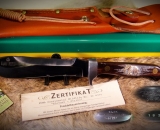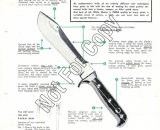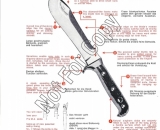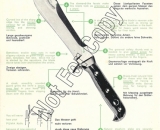This iconic knife was the result of a collaborative effort by PUMA and the East Africa Professional Hunter’s Association. It was first introduced in 1956 and set the standard by which all other hunting knives were measured for the next 50 years. Otto von Frankenburg, the husband of Renate Lauterjung, a decendant of Franz Lauterjung was in charge at PUMA . It was von Frankenburg’s influence in the company that transitioned the company into a comprehensive hunting knife maker. He enlisted the help of a friend, Walter Frevert, who was the Head of Forestry in Germany. Both men were active hunters.
The shape of the blade at that time was a unique feature of the knife. The point was off-set from the center axis to penetrate deep in the flesh even if it hit bone. The convex curve of the blade allowed more cutting edge to come in contact with the meat and skin. The amount of steel in the blade allowed for the blade to be re-sharpened many times while retaining its convex shape. The finest Indian Sambar Stag was used to make the grips on the handle. The knife was a full tang design. The handles were held together by brass rivets.
Designed by Puma and field tested in Africa, the locals gave it the name White Hunter, named after the European and North American hunters who came often to Africa on Safari. Many of these knives were often presented as gift to the guides and trackers by the hunters at the end of the hunt.















